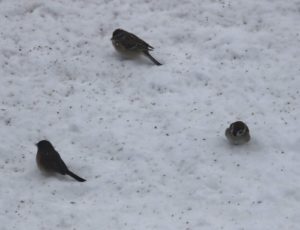Project Feederwatch!

Eurasian tree sparrow at right.
This Saturday begins this year’s annual Project Feederwatch, a great opportunity to put the time you spend looking out at your yard to use for citizen science. Join more than 20,000 bird-lovers, bird-watchers, and seed-enthusiasts in observing and counting the birds that show up to feeders in your yard throughout the cold winter months.
A program of the Cornell Lab of Ornithology (an amazing resource for all things bird), Project Feederwatch has been around for more than thirty years, gathering data on trends in winter bird populations with the help of interested citizens. Participants can spend as much or as little time as they like: sit at your window for hours and count, or just glance out the window every time you pass by each weekend. Or one weekend a month. Or once a year! Even better to take part year after year, to see how the species and numbers change over time.
In previous years I may have…complained? opined? at the dearth of species in and around my yard, located in a newer subdivision with few large trees. My previous neighborhood, with a canopy of huge oaks, sycamores and other venerables, brought a delightful array of woodpeckers, chickadees, titmice, and other winter regulars whereas the new place…house sparrows. And a few mourning doves.
Last winter, however, I embraced my sparrow-friendly habitat and, instead of using just a tube feeder and a small platform, I began scattering sunflower hearts widely around the space in front of the garden. It was close enough to the cover of the standing stems for birds to feel safe, but open enough for me to see and count from an upstairs window. With the food availability spread beyond the two small feeders, I was treated to…sparrows. But wait! Not just the usual clan of house sparrows but also dark-eyed Juncos, song sparrows, American tree sparrows, and my favorite prize of all, a single Eurasian tree sparrow.
Each week would bring the same house sparrows and mourning doves. But some days the wider group would show, including my Eurasian tree sparrow as well as what appeared to be an Oregon form of dark-eyed junco, with a black hood and chestnut sides. It was a little motivation to keep the seed stocked and check out the window regularly, in hopes of catching sight of one of these less-regular visitors.
So each week I collect my data, and enter it into the Project Feederwatch site. My data, along with data from all the other feederwatchers across the continent, is available to explore. For example, there were around 60 count sites in Iowa reporting data last year; you can see a breakdown of all the species counted over the course of the winter. You can also view your own data year over year; I am looking forward to seeing more cardinals and chickadees in coming years as our neighborhood trees grow, but in the meantime I can enjoy my hardy sparrow friends.
If you don’t yet participate in Project Feederwatch, consider it! A participation fee of $18 offsets the costs of the participant’s kit, and offers access to tons of information and helpful hints for identifying birds…not to mention helping to collect valuable data about bird populations right in your own neighborhood. You don’t need to be an expert at bird identification (they provide a poster with commonly-seen birds when you sign up), just interested in watching the birds outside your window.
Originally published in Sycamore Greenway Friends.


